Comprehensive characterization of a time-course transcriptional response induced by autotoxins in Panax ginseng using RNA-Seq
- PMID: 26608743
- PMCID: PMC4659204
- DOI: 10.1186/s12864-015-2151-7
Comprehensive characterization of a time-course transcriptional response induced by autotoxins in Panax ginseng using RNA-Seq
Abstract
Background: As a valuable medicinal plant, the yield of Panax ginseng is seriously affected by autotoxicity, which is a common phenomenon due to continuous cropping. However, the mechanism of autotoxicity in P. ginseng is still unknown.
Results: In total, high throughput sequencing of 18 RNA-Seq libraries produced 996,000,000 100-nt reads that were assembled into 72,732 contigs. Compared with control, 3697 and 2828 genes were significantly up- and down-regulated across different tissues and time points, respectively. Gene Ontology enrichment analysis showed that 'enzyme inhibitor activity', 'carboxylesterase activity', 'pectinesterase activity', 'centrosome cycle and duplication' and 'mitotic spindle elongation' were enriched for the up-regulated genes. Transcription factors including AP2s/ERFs, MYBs, and WRKYs were up-regulated in roots after benzoic acid treatment. Moreover, reactive oxygen species, peroxidases and superoxide dismutase contigs were up-regulated in roots after benzoic acid treatment. Physiological and biochemical indexes showed that the proline and malondialdehyde content were restored to lower levels at a later stage after benzoic acid treatment. Benzoic acid inhibited the root hair development in a dose-dependent manner, and several differential expressed genes potentially involved in hair development were identified. Several key contigs in the flavonoid and ginsenoside biosynthesis pathways were repressed. Finally, 58,518 alternative splicing (AS) events from 12,950 genes were found after benzoic acid treatment. Interestingly, contigs in the ginsenoside biosynthetic pathway underwent AS, providing useful information about post-transcriptional regulation in P. ginseng.
Conclusions: This study revealed the stress-response molecular mechanisms in P. ginseng induced by benzoic acid.
Figures

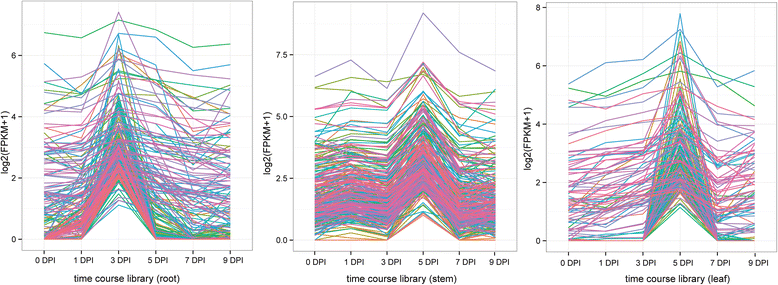
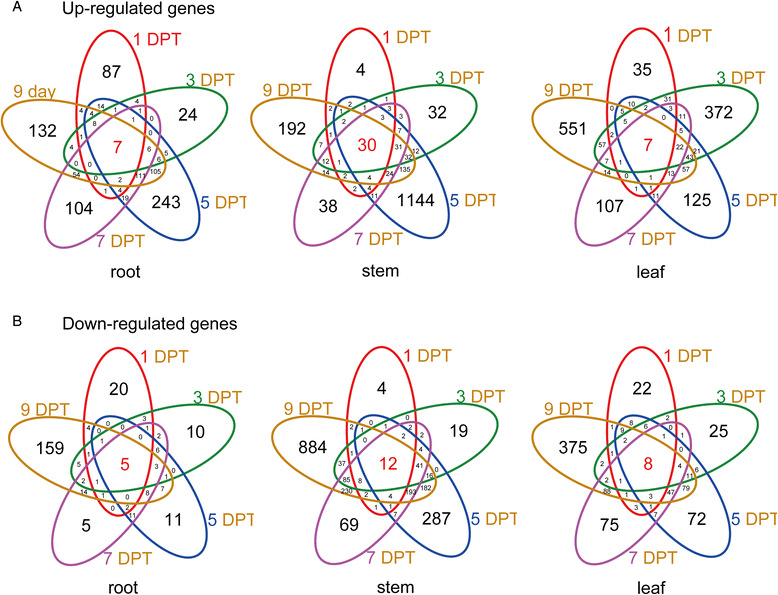
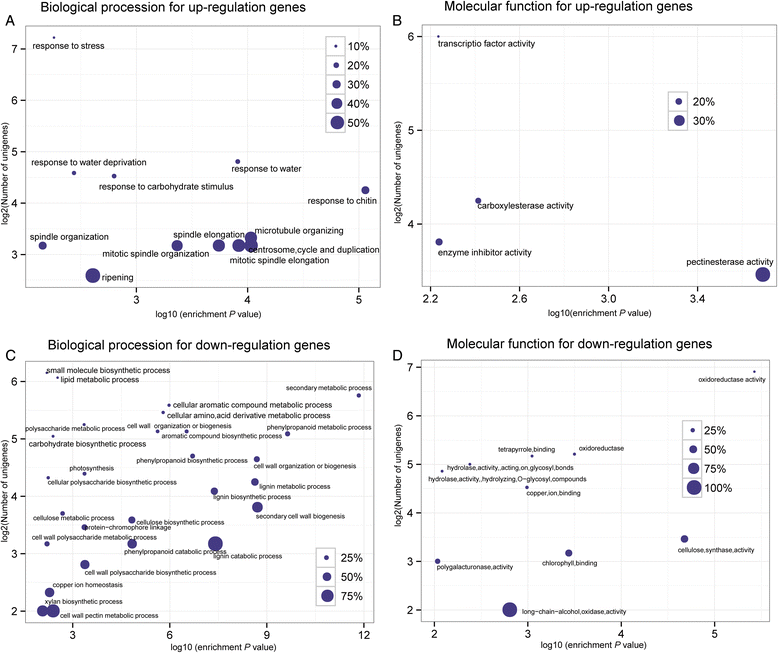
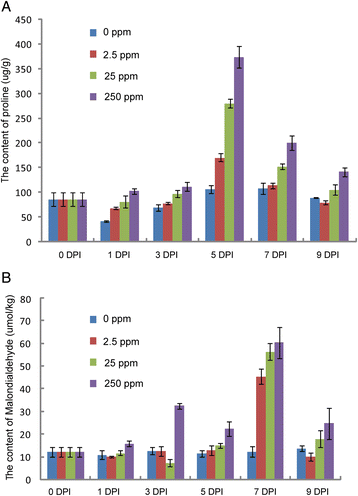

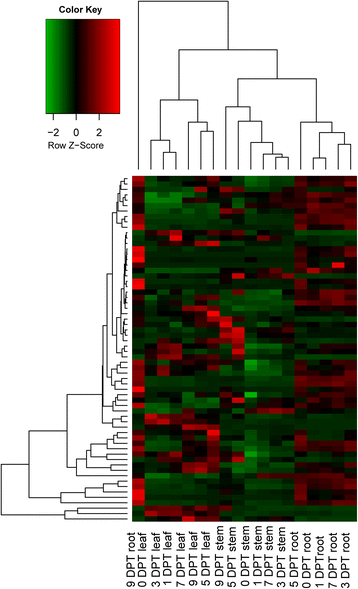

Similar articles
-
Time-Course Transcriptome Analysis Reveals Resistance Genes of Panax ginseng Induced by Cylindrocarpon destructans Infection Using RNA-Seq.PLoS One. 2016 Feb 18;11(2):e0149408. doi: 10.1371/journal.pone.0149408. eCollection 2016. PLoS One. 2016. PMID: 26890788 Free PMC article.
-
The Spatial and Temporal Transcriptomic Landscapes of Ginseng, Panax ginseng C. A. Meyer.Sci Rep. 2015 Dec 11;5:18283. doi: 10.1038/srep18283. Sci Rep. 2015. PMID: 26655864 Free PMC article.
-
Transcriptomic profiling reveals MEP pathway contributing to ginsenoside biosynthesis in Panax ginseng.BMC Genomics. 2019 May 17;20(1):383. doi: 10.1186/s12864-019-5718-x. BMC Genomics. 2019. PMID: 31101014 Free PMC article.
-
Progress in understanding of ginsenoside biosynthesis.Plant Biol (Stuttg). 2008 Jul;10(4):415-21. doi: 10.1111/j.1438-8677.2008.00064.x. Plant Biol (Stuttg). 2008. PMID: 18557901 Review.
-
[Advance in transcriptomic studies of ginseng species].Zhongguo Zhong Yao Za Zhi. 2016 Nov;41(22):4138-4143. doi: 10.4268/cjcmm20162209. Zhongguo Zhong Yao Za Zhi. 2016. PMID: 28933079 Review. Chinese.
Cited by
-
The spatiotemporal regulations of epicatechin biosynthesis under normal flowering and the continuous inflorescence removal treatment in Fagopyrum dibotrys.BMC Plant Biol. 2022 Jul 29;22(1):379. doi: 10.1186/s12870-022-03761-z. BMC Plant Biol. 2022. PMID: 35906545 Free PMC article.
-
Nitrogen Fertilization in a Faba Bean-Wheat Intercropping System Can Alleviate the Autotoxic Effects in Faba Bean.Plants (Basel). 2023 Mar 8;12(6):1232. doi: 10.3390/plants12061232. Plants (Basel). 2023. PMID: 36986921 Free PMC article.
-
Autotoxin Rg1 Induces Degradation of Root Cell Walls and Aggravates Root Rot by Modifying the Rhizospheric Microbiome.Microbiol Spectr. 2021 Dec 22;9(3):e0167921. doi: 10.1128/spectrum.01679-21. Epub 2021 Dec 15. Microbiol Spectr. 2021. PMID: 34908454 Free PMC article.
-
Panax notoginseng Root Cell Death Caused by the Autotoxic Ginsenoside Rg1 Is Due to Over-Accumulation of ROS, as Revealed by Transcriptomic and Cellular Approaches.Front Plant Sci. 2018 Feb 28;9:264. doi: 10.3389/fpls.2018.00264. eCollection 2018. Front Plant Sci. 2018. PMID: 29541087 Free PMC article.
-
Physiological and transcriptomic analyses provide preliminary insights into the autotoxicity of Lilium brownii.Front Plant Sci. 2024 May 14;15:1330061. doi: 10.3389/fpls.2024.1330061. eCollection 2024. Front Plant Sci. 2024. PMID: 38807780 Free PMC article.
References
-
- Huang LF, Song LX, Xia XJ, Mao WH, Shi K, Zhou YH, et al. Plant-soil feedbacks and soil sickness: from mechanisms to application in agriculture. J Chem Ecol. 2013;39(2):232–42. - PubMed
-
- Miller DA. Allelopathy in forage crop systems. Agron J. 1996;88:854–859. doi: 10.2134/agronj1996.00021962003600060003x. - DOI
-
- Chou C-H, Lin H-J. Autointoxication mechanism of Oryza sativa L. Phytotoxic effects of decomposing rice residues in soil. J Chem Ecol. 1976;2(3):353–367. doi: 10.1007/BF00988282. - DOI
-
- Hao Z, Wang Q, Christie P, Li X. Allelopathic potential of watermelon tissues and root exudates. Sci Hortic. 2007;112(3):315–320. doi: 10.1016/j.scienta.2006.12.030. - DOI
Publication types
MeSH terms
Substances
LinkOut - more resources
Full Text Sources
Other Literature Sources
Research Materials

